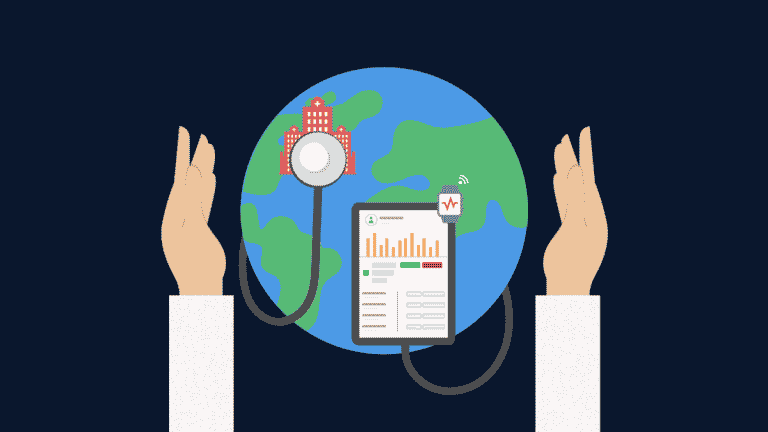Contents
Introduction
Before the introduction of the Internet of things in digital healthcare, providing assistance to patients in areas with limited access to hospitals and doctors was a true challenge, with patients’ interactions with doctors limited to in-person visits and communications through text. Regular monitoring and prompt response in case of medical emergencies such as heart failure, asthma attacks, sudden drop in blood pressure or oxygen levels was an unimaginable task. The rising costs of healthcare facilities had already led to the development of “medical tourism”, wherein patients with critical health conditions have been traveling to developing countries to access cheaper medical facilities. IoT implementation in the digital health infrastructure has provided effective solutions to these and numerous other challenges in the industry.
Why Is IoT Important In Healthcare?
The advent of inexpensive and faster computer chips and high bandwidth telecommunication has ensured the efficient use of Internet of things in organizations across a variety of industries.
The use of IoT has been on a steady rise. This is being used to improve quality of life while reducing costs, with the market predicted to exceed USD 188.2 billion by 2025. Devices developed using Internet of things make use of constantly evolving techs, such as conversational AI/ML and analytics, big data, and cloud computing platforms to create functional, modern and useful solutions for patients and medical industry workers alike.
How Is IoT Redefining The Healthcare Industry?
It offers several benefits in the digital health sector, including the ability to monitor patients more closely than ever before. Some of the technological benefits include digital devices for diagnostics, health-care procedure assists, delivery of services and medications. Remote tracking and virtual visits keep patients and doctors always connected. Digital wellness devices collect and analyze data to align organizational communication. Hospital facilities use this technology to track patients and staff, allowing workers to advance beyond the confines of a clinic or hospital.
GeekyAnts-Blockchain and on-demand app development company, has made significant contributions to this sector digitally, helping medical businesses around the world. They have helped a non-profit organization based in USA to develop resources to bring down suicide rates among teenagers, an Australian medical organisation to facilitate effective healthcare for locals, and has created a support group app for an American virtual treatment program.
Benefits Of IoT In Healthcare
The application of I.o.T has helped improve digital health Industry in several ways:
- medical devices : These include, but are not limited to, medical apps, equipment tagged with embedded systems that help track vital signs in real time, transfer medical data, monitor temperature for vaccines and samples, track air quality, provide remote care systems and monitor sleep patterns for adults and children.
- For depression : These devices help patients suffering from severe depression to monitor their cognitive functions.
- For communication : Combined with Data Engineering, IoT devices improve medical care operations by helping healthcare professionals, consumers, and smart medical institutions communicate more efficiently.
- Affordable clinical services : A tech-driven system reduces costs associated with health-care by eliminating unnecessary visits, utilizing resources in an efficient manner, and improving planning, communication, and implementation.
Applications Of IoT In Healthcare
Some applications includes
- Remote temperature monitoring : With the help of Internet of Things, cold chain monitoring for vaccines, medicines and clinical samples has become easier.
- Remote patient Tracking : These devices can monitor an individual’s health without a physical exam. Examples include health apps, smart watches, insulin pens, pulse sensors and ingestible sensors.
- Treatment of mental illness : Certain apps offer individuals with mental illness problems to access help and support in the form of online therapy, or through chatbots that offer real-time assistance. For instance, a US based Healthcare digital solution development company has worked with Ivy Sky and Marigold Health, USA, creating apps to help bring down suicide rates among teens and to create a support group for mental illness therapy respectively, using this tech.
- Effective communication between organizations : Health and wellness facilities are capable of reducing errors, saving time and resources, while delivering effective care to patients. This Global digital consultancy has worked with an Australian healthcare organization to create a web app that facilitates effective medical care by aligning medical organizations.
Challenges Of IoT In Healthcare And Wellness
There are several challenges that the I.o.T technology needs to overcome, some of which are as follows
- Cybersecurity : Devices connected to the internet are susceptible to hacking. These devices require layers of security owing to the sensitive nature of the data that is collected and shared on and through these devices.
- Seamless platforms : This technology should be scalable enough to seamlessly integrate into the health and wellness system. Troubleshooting should be made easy.
- Connectivity : Network failures can pose a real challenge to the devices that require real-time access to data.
- Cost : To gain total optimization from these devices, they should be made cost effective and more easily accessible.
Wellness digital solution development companies are dedicated to producing highly functional, cost-effective healthcare applications, keeping in mind these challenges.
The Future Of IoT In Healthcare Industry
With rapid technological advancements, the possibilities for improving the health and wellness infrastructure using IoT are endless. Healthcare and wellness app development companies will help create scalable, secure and user-friendly wellness apps, keeping up with the latest trends in digital medical technology.

